Tropical cyclone naming
Tropical cyclones and subtropical cyclones are named by various warning centers to simplify communication between forecasters and the general public regarding forecasts, watches, and warnings. The names are intended to reduce confusion in the event of concurrent storms in the same basin. Generally once storms produce sustained wind speeds of more than 33 knots (61 km/h; 38 mph), names are assigned in order from predetermined lists depending on which basin they originate. However, standards vary from basin to basin: some tropical depressions are named in the Western Pacific, while tropical cyclones must have a significant amount of gale-force winds occurring around the centre before they are named in the Southern Hemisphere.
| Part of a series on |
| Tropical cyclones |
|---|
|
Outline of tropical cyclones |
Before the formal start of naming, tropical cyclones were named after places, objects, or saints' feast days on which they occurred. The credit for the first usage of personal names for weather systems is generally given to the Queensland Government Meteorologist Clement Wragge, who named systems between 1887 and 1907. This system of naming weather systems subsequently fell into disuse for several years after Wragge retired, until it was revived in the latter part of World War II for the Western Pacific. Formal naming schemes and naming lists have subsequently been introduced and developed for the Eastern, Central, Western and Southern Pacific basins, as well as the Australian region, Atlantic Ocean and Indian Ocean.
History
| Tropical cyclone naming institutions | |||
|---|---|---|---|
| Basin | Institution | Area of responsibility | |
| North Atlantic Eastern Pacific | United States National Hurricane Center | Equator northward, European and African Atlantic Coasts – 140°W | [1] |
| Central Pacific | United States Central Pacific Hurricane Center | Equator northward, 140°W - 180° | [1] |
| Western Pacific | Japan Meteorological Agency PAGASA (Unofficial) | Equator – 60°N, 180 – 100°E 5°N – 21°N, 115°E – 135°E | [2] [3] |
| North Indian Ocean | India Meteorological Department | Equator northward, 100°E – 40°E | [4] |
| South-West Indian Ocean | Mauritius Meteorological Services Météo Madagascar Météo France Reunion | Equator – 40°S, 55°E – 90°E Equator – 40°S, African Coast – 55°E Equator – 40°S, African Coast – 90°E | [5] |
| Australian region | Indonesian Agency for Meteorology, Climatology and Geophysics Papua New Guinea National Weather Service Australian Bureau of Meteorology | Equator – 10°S, 90°E – 141°E Equator – 10°S, 141°E – 160°E 10°S – 40°S, 90°E – 160°E | [6] |
| Southern Pacific | Fiji Meteorological Service Meteorological Service of New Zealand | Equator – 25°S, 160°E – 120°W 25°S – 40°S, 160°E – 120°W | [6] |
| South Atlantic | Brazilian Navy Hydrographic Center (Unofficial) | Equator – 35°S, Brazilian Coast – 20°W | [7] |
Before the formal start of naming, tropical cyclones were often named after places, objects, or saints' feast days on which they occurred.[8] The credit for the first usage of personal names for weather systems is generally given to the Queensland Government Meteorologist Clement Wragge, who named systems between 1887 and 1907.[8] This system of naming weather systems subsequently fell into disuse for several years after Wragge retired until it was revived in the latter part of World War II for the Western Pacific.[8] Formal naming schemes have subsequently been introduced for the North Atlantic, Eastern, Central, Western and Southern Pacific basins as well as the Australian region and Indian Ocean.[8]
At present, tropical cyclones are officially named by one of eleven warning centers and retain their names throughout their lifetimes to facilitate the effective communication of forecasts and storm-related hazards to the general public.[9] This is especially important when multiple storms are occurring simultaneously in the same ocean basin.[9] Names are generally assigned in order from predetermined lists, once they produce one, three, or ten-minute sustained wind speeds of more than 65 km/h (40 mph).[1][4][5] However, standards vary from basin to basin, with some systems named in the Western Pacific when they develop into tropical depressions or enter PAGASA's area of responsibility.[3] Within the Southern Hemisphere, systems must be characterized by a significant amount of gale-force winds occurring around the center before they are named.[5][6]
Any member of the World Meteorological Organization's hurricane, typhoon and tropical cyclone committees can request that the name of a tropical cyclone be retired or withdrawn from the various tropical cyclone naming lists.[1][2][6] A name is retired or withdrawn if a consensus or majority of members agree that the system has acquired a special notoriety, such as causing a large number of deaths and amounts of damage, impact, or for other special reasons.[1] A replacement name is then submitted to the committee concerned and voted upon, but these names can be rejected and replaced with another name for various reasons: these reasons include the spelling and pronunciation of the name, the similarity to the name of a recent tropical cyclone or on another list of names, and the length of the name for modern communication channels such as social media.[1][2][10] PAGASA also retires the names of significant tropical cyclones when they have caused at least ₱1 billion in damage or have caused at least 300 deaths.[11]
North Atlantic Ocean
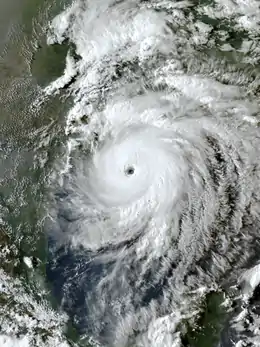
Within the North Atlantic Basin, tropical or subtropical storms are named by the United States National Hurricane Center (NHC/RSMC Miami), when they are judged to have 1-minute sustained winds of at least 34 kn (39 mph; 63 km/h).[1] The name selected comes from one of six rotating alphabetic lists of twenty-one names, that are maintained by the World Meteorological Organization's RA IV Hurricane Committee.[1] These lists skip the letters Q, U, X, Y and Z, rotate from year to year and alternate between male and female names.[1] The names of significant tropical cyclones are retired from the lists, with a replacement name selected at the next meeting of the Hurricane Committee.[1] If all of the names on a list for a season are used, any additional tropical or subtropical storms are named after the letters of the Greek alphabet.[1] Should any of these letters need to be retired, then the letter would be listed as retired; however, the Greek letter would remain available.[1]
| 2019 | |||||||||||
|---|---|---|---|---|---|---|---|---|---|---|---|
| Names | Andrea | Barry | Chantal | Dorian | Erin | Fernand | Gabrielle | Humberto | Imelda | Jerry | Karen |
| Lorenzo | Melissa | Nestor | Olga | Pablo | Rebekah | Sebastien | Tanya | Van | Wendy | ||
| 2020 | |||||||||||
| Names | Arthur | Bertha | Cristobal | Dolly | Edouard | Fay | Gonzalo | Hanna | Isaias | Josephine | Kyle |
| Laura | Marco | Nana | Omar | Paulette | Rene | Sally | Teddy | Vicky | Wilfred | ||
| 2021 | |||||||||||
| Names | Ana | Bill | Claudette | Danny | Elsa | Fred | Grace | Henri | Ida | Julian | Kate |
| Larry | Mindy | Nicholas | Odette | Peter | Rose | Sam | Teresa | Victor | Wanda | ||
| 2022 | |||||||||||
| Names | Alex | Bonnie | Colin | Danielle | Earl | Fiona | Gaston | Hermine | Ian | Julia | Karl |
| Lisa | Martin | Nicole | Owen | Paula | Richard | Shary | Tobias | Virginie | Walter | ||
| 2023 | |||||||||||
| Names | Arlene | Bret | Cindy | Don | Emily | Franklin | Gert | Harold | Idalia | Jose | Katia |
| Lee | Margot | Nigel | Ophelia | Philippe | Rina | Sean | Tammy | Vince | Whitney | ||
| 2024 | |||||||||||
| Names | Alberto | Beryl | Chris | Debby | Ernesto | Francine | Gordon | Helene | Isaac | Joyce | Kirk |
| Leslie | Milton | Nadine | Oscar | Patty | Rafael | Sara | Tony | Valerie | William | ||
Eastern Pacific Ocean
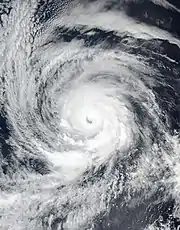
Within the Eastern Pacific Ocean, there are two warning centers that assign names to tropical cyclones on behalf of the World Meteorological Organization when they are judged to have intensified into a tropical storm with winds of at least 34 kn (39 mph; 63 km/h).[1] Tropical cyclones that intensify into tropical storms between the coast of Americas and 140°W are named by the National Hurricane Center (NHC/RSMC Miami), while tropical cyclones intensifying into tropical storms between 140°W and 180° are named by the Central Pacific Hurricane Center (CPHC/RSMC Honolulu).[1] Significant tropical cyclones have their names retired from the lists and a replacement name selected at the next World Meteorological Organization Hurricane Committee.[1]
North Pacific (east of 140°W)
When a tropical depression intensifies into a tropical storm to the north of the Equator between the coastline of the Americas and 140°W, it will be named by the NHC. There are six lists of names which rotate every six years and begin with the letters A—Z used, skipping Q and U, with each name alternating between a male or a female name.[1] The names of significant tropical cyclones are retired from the lists, with a replacement name selected at the next meeting of the Hurricane Committee.[1] If all of the names on a list are used, storms are named using the letters of the Greek alphabet.[1]
| 2019 | ||||||||||||
|---|---|---|---|---|---|---|---|---|---|---|---|---|
| Names | Alvin | Barbara | Cosme | Dalila | Erick | Flossie | Gil | Henriette | Ivo | Juliette | Kiko | Lorena |
| Mario | Narda | Octave | Priscilla | Raymond | Sonia | Tico | Velma | Wallis | Xina | York | Zelda | |
| 2020 | ||||||||||||
| Names | Amanda | Boris | Cristina | Douglas | Elida | Fausto | Genevieve | Hernan | Iselle | Julio | Karina | Lowell |
| Marie | Norbert | Odalys | Polo | Rachel | Simon | Trudy | Vance | Winnie | Xavier | Yolanda | Zeke | |
| 2021 | ||||||||||||
| Names | Andres | Blanca | Carlos | Dolores | Enrique | Felicia | Guillermo | Hilda | Ignacio | Jimena | Kevin | Linda |
| Marty | Nora | Olaf | Pamela | Rick | Sandra | Terry | Vivian | Waldo | Xina | York | Zelda | |
| 2022 | ||||||||||||
| Names | Agatha | Blas | Celia | Darby | Estelle | Frank | Georgette | Howard | Ivette | Javier | Kay | Lester |
| Madeline | Newton | Orlene | Paine | Roslyn | Seymour | Tina | Virgil | Winifred | Xavier | Yolanda | Zeke | |
| 2023 | ||||||||||||
| Names | Adrian | Beatriz | Calvin | Dora | Eugene | Fernanda | Greg | Hilary | Irwin | Jova | Kenneth | Lidia |
| Max | Norma | Otis | Pilar | Ramon | Selma | Todd | Veronica | Wiley | Xina | York | Zelda | |
| 2024 | ||||||||||||
| Names | Aletta | Bud | Carlotta | Daniel | Emilia | Fabio | Gilma | Hector | Ileana | John | Kristy | Lane |
| Miriam | Norman | Olivia | Paul | Rosa | Sergio | Tara | Vicente | Willa | Xavier | Yolanda | Zeke | |
| References:[1] | ||||||||||||
Central North Pacific Ocean (140°W to 180°)
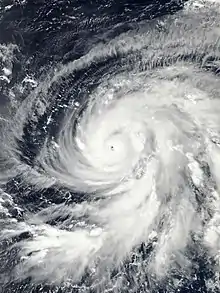
When a tropical depression intensifies into a tropical storm to the north of the Equator between 140°W and 180°, it is named by the CPHC.[1] Four lists of Hawaiian names are maintained by the World Meteorological Organization's hurricane committee, rotating without regard to year, with the first name for a new year being the next name in sequence that was not used the previous year.[1] The names of significant tropical cyclones are retired from the lists, with a replacement name selected at the next Hurricane Committee meeting.[1]
| List | Names | ||||||||||||
|---|---|---|---|---|---|---|---|---|---|---|---|---|---|
| 1 | Akoni | Ema | Hone | Iona | Keli | Lala | Moke | Nolo | Olana | Pena | Ulana | Wale | |
| 2 | Aka | Ekeka | Hene | Iolana | Keoni | Lino | Mele | Nona | Oliwa | Pama | Upana | Wene | |
| 3 | Alika | Ele | Huko | Iopa | Kika | Lana | Maka | Neki | Omeka | Pewa | Unala | Wali | |
| 4 | Ana | Ela | Halola | Iune | Kilo | Loke | Malia | Niala | Oho | Pali | Ulika | Walaka | |
| References:[1] | |||||||||||||
Western Pacific Ocean (180° – 100°E)

Tropical cyclones that occur within the Northern Hemisphere between the anti-meridian and 100°E are officially named by the Japan Meteorological Agency when they become tropical storms.[2] However, PAGASA also names tropical cyclones that occur or develop into tropical depressions within their self-defined area of responsibility between 5°N–25°N and 115°E–135°E.[3] This often results in tropical cyclones in the region having two names.[3]
International names
Tropical cyclones within the Western Pacific are assigned international names by the Japan Meteorological Agency when they become a tropical storm with 10-minute sustained winds of at least 34 kn (39 mph; 63 km/h).[2] The names are used sequentially without regard to year and are taken from five lists of names that were prepared by the ESCAP/WMO Typhoon Committee, after each of the 14 members submitted 10 names in 1998.[2] The order of the names to be used was determined by placing the English name of the members in alphabetical order.[2] Members of the committee are allowed to request the retirement or replacement of a system's name if it causes extensive destruction or for other reasons such as number of deaths.[2]
Philippines
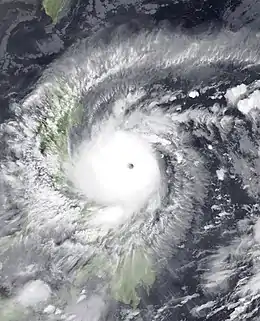
Since 1963, PAGASA has independently operated its own naming scheme for tropical cyclones that occur within its own self-defined Philippine Area of Responsibility.[3][15] The names are taken from four different lists of 25 names and are assigned when a system moves into or develops into a tropical depression within PAGASA's jurisdiction.[3][15] The four lists of names are rotated every four years, with the names of significant tropical cyclones retired should they have caused at least ₱1 billion in damage and/or at least 300 deaths within the Philippines;[15][16] replacements to retired names are taken from the agency's list of reserved names.[15] Should the list of names for a given year be exhausted, names are taken from an auxiliary list, the first ten of which are published every year.[15]
| 2021 | |||||||||||||||||||
|---|---|---|---|---|---|---|---|---|---|---|---|---|---|---|---|---|---|---|---|
| Main | Auring | Bising | Crising | Dante | Emong | Fabian | Gorio | Huaning | Isang | Jolina | Kiko | Lannie | Maring | ||||||
| Nando | Odette | Paolo | Quedan | Ramil | Salome | Tino | Uwan | Verbena | Wilma | Yasmin | Zoraida | ||||||||
| Auxiliary | Alamid | Bruno | Conching | Dolor | Ernie | Florante | Gerardo | Hernan | Isko | Jerome | |||||||||
| 2022 | |||||||||||||||||||
| Main | Agaton | Basyang | Caloy | Domeng | Ester | Florita | Gardo | Henry | Inday | Josie | Karding | Luis | Maymay | ||||||
| Neneng | Obet | Paeng | Queenie | Rosal | Samuel | Tomas | Umberto | Venus | Waldo | Yayang | Zeny | ||||||||
| Auxiliary | Agila | Bagwis | Chito | Diego | Elena | Felino | Gunding | Harriet | Indang | Jessa | |||||||||
| 2023 | |||||||||||||||||||
| Main | Amang | Betty | Chedeng | Dodong | Egay | Falcon | Goring | Hanna | Ineng | Jenny | Kabayan | Liwayway | Marilyn | ||||||
| Nimfa | Onyok | Perla | Quiel | Ramon | Sarah | Tamaraw | Ugong | Viring | Weng | Yoyoy | Zigzag | ||||||||
| Auxiliary | Abe | Berto | Charo | Dado | Estoy | Felion | Gening | Herman | Irma | Jaime | |||||||||
| 2024 | |||||||||||||||||||
| Main | Aghon | Butchoy | Carina | Dindo | Enteng | Ferdie | Gener | Helen | Igme | Julian | Kristine | Leon | Marce | ||||||
| Nika | Ofel | Pepito | Querubin | Romina | Siony | Tonyo | Upang | Vicky | Warren | Yoyong | Zosimo | ||||||||
| Auxiliary | Alakdan | Baldo | Clara | Dencio | Estong | Felipe | Gomer | Heling | Ismael | Julio | |||||||||
| References:[15] | |||||||||||||||||||
North Indian Ocean (45°E – 100°E)
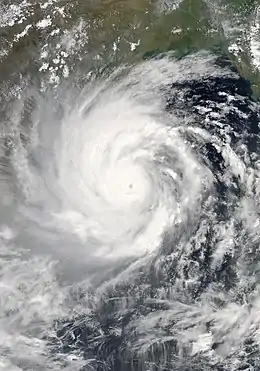
Within the North Indian Ocean between 45°E – 100°E, tropical cyclones are named by the India Meteorological Department (IMD/RSMC New Delhi) when they are judged to have intensified into cyclonic storms with 3-minute sustained wind speeds of at least 34 kn (39 mph; 63 km/h).[4] Should a cyclonic storm move into the basin from the Western Pacific then it will keep its original name.[4] However, if the system should weaken into a deep depression and subsequently reintensify after moving into the region then will be assigned a new name.[4] In May 2020, the naming of Cyclone Amphan exhausted the original list of names established in 2004.[4] A new list of names has been prepared and will be used in alphabetical order for storms after Amphan.[4][17]
| List | Contributing nation | ||||||||||||
|---|---|---|---|---|---|---|---|---|---|---|---|---|---|
| Bangladesh | India | Iran | Maldives | Myanmar | Oman | Pakistan | Qatar | Saudi Arabia | Sri Lanka | Thailand | U.A.E. | Yemen | |
| 1 | Nisarga | Gati | Nivar | Burevi | Tauktae | Yaas | Gulab | Shaheen | Jawad | Asani | Sitrang | Mandous | Mocha |
| 2 | Biparjoy | Tej | Hamoon | Midhili | Michaung | Remal | Asna | Dana | Fengal | Shakhti | Montha | Senyar | Ditwah |
| 3 | Arnab | Murasu | Akvan | Kaani | Ngamann | Sail | Sahab | Lulu | Ghazeer | Gigum | Thianyot | Afoor | Diksam |
| 4 | Upakul | Aag | Sepand | Odi | Kyarthit | Naseem | Afshan | Mouj | Asif | Gagana | Bulan | Nahhaam | Sira |
| 5 | Barshon | Vyom | Booran | Kenau | Sapakyee | Muzn | Manahil | Suhail | Sidrah | Verambha | Phutala | Quffal | Bakhur |
| 6 | Rajani | Jhar | Anahita | Endheri | Wetwun | Sadeem | Shujana | Sadaf | Hareed | Garjana | Aiyara | Daaman | Ghwyzi |
| 7 | Nishith | Probaho | Azar | Riyau | Mwaihout | Dima | Parwaz | Reem | Faid | Neeba | Saming | Deem | Hawf |
| 8 | Urmi | Neer | Pooyan | Guruva | Kywe | Manjour | Zannata | Rayhan | Kaseer | Ninnada | Kraison | Gargoor | Balhaf |
| 9 | Meghala | Prabhanjan | Arsham | Kurangi | Pinku | Rukam | Sarsar | Anbar | Nakheel | Viduli | Matcha | Khubb | Brom |
| 10 | Samiron | Ghurni | Hengame | Kuredhi | Yinkaung | Watad | Badban | Oud | Haboob | Ogha | Mahingsa | Degl | Shuqra |
| 11 | Pratikul | Ambud | Savas | Horangu | Linyone | Al-jarz | Sarrab | Bahar | Bareq | Salitha | Phraewa | Athmad | Fartak |
| 12 | Sarobor | Jaladhi | Tahamtan | Thundi | Kyeekan | Rabab | Gulnar | Seef | Alreem | Rivi | Asuri | Boom | Darsah |
| 13 | Mahanisha | Vega | Toofan | Faana | Bautphat | Raad | Waseq | Fanar | Wabil | Rudu | Thara | Saffar | Samhah |
South-West Indian Ocean (Africa – 90°E)
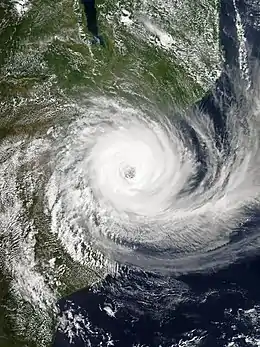
Within the South-West Indian Ocean in the Southern Hemisphere between Africa and 90°E, a tropical or subtropical disturbance is named when it is judged to have intensified into a tropical storm with winds of at least 34 kn (39 mph; 63 km/h).[5][18] This is defined as being when gales are either observed or estimated to be present near a significant portion of the system's center.[5] Systems are named in conjunction with Météo-France Reunion by either Météo Madagascar or the Mauritius Meteorological Service.[5] If a disturbance reaches the naming stage between Africa and 55°E, then Météo Madagascar names it; if it reaches the naming stage between 55°E and 90°E, then the Mauritius Meteorological Service names it.[5] The names are taken from three pre-determined lists of names, which rotate on a triennial basis, with any names that have been used automatically removed.[5] These names are then replaced by the WMO's RA I Tropical Cyclone Committee, with names submitted by member nations.[5]
| 2020–21 | |||||||||||||
|---|---|---|---|---|---|---|---|---|---|---|---|---|---|
| Names | Alicia | Bongoyo | Chalane | Danilo | Eloise | Faraji | Guambe | Habana | Iman | Jobo | Kanga | Ludzi | Melina |
| Nathan | Onias | Pelagie | Quamar | Rita | Solani | Tarik | Urilia | Vuyane | Wagner | Xusa | Yarona | Zacarias | |
| 2021–22 | |||||||||||||
| Names | Ana | Batsirai | Cliff | Damako | Emnati | Fezile | Gombe | Halima | Issa | Jasmine | Karim | Letlama | Maipelo |
| Njazi | Oscar | Pamela | Quentin | Rajab | Savana | Themba | Uyapo | Viviane | Walter | Xangy | Yemurai | Zanele | |
| 2022–23[nb 7] | |||||||||||||
| Names | Ambali | Belna | Calvinia | Diane | Esami | Francisco | Gabekile | Herold | Irondro | Jeruto | Kundai | Lisebo | Michel |
| Nousra | Olivier | Pokera | Quincy | Rebaone | Salama | Tristan | Ursula | Violet | Wilson | Xila | Yekela | Zania | |
| References:[18][19] | |||||||||||||
Australian Region (90°E – 160°E)
Within the Australian region in the Southern Hemisphere between 90°E – 160°E, a tropical cyclone is named when observations or Dvorak intensity analysis indicate that a system has gale force or stronger winds near the center which are forecast to continue.[6] The Indonesian Badan Meteorologi, Klimatologi, dan Geofisika names systems that develop between the Equator and 10°S and 90°E and 141°E, while Papua New Guinea's National Weather Service names systems that develop between the Equator and 10°S and 141°E and 160°E.[6] Outside of these areas, the Australian Bureau of Meteorology names systems that develop into tropical cyclones.[6] In order to enable local authorities and their communities in taking action to reduce the impact of a tropical cyclone, each of these warning centres reserve the right to name a system early if it has a high chance of being named.[6] If a name is assigned to a tropical cyclone that causes loss of life or significant damage and disruption to the way of life of a community, then the name assigned to that storm is retired from the list of names for the region.[6] A replacement name is then submitted to the next World Meteorological Organization's RA V Tropical Cyclone Committee meeting.[6]
Indonesia
If a system intensifies into a tropical cyclone between the Equator – 10°S and 90°E – 141°E, it will be named by the Badan Meteorologi, Klimatologi, dan Geofisika (BMKG/TCWC Jakarta).[6] Names are assigned in sequence from list A, while list B details names that will replace names on list A that are retired or removed for other reasons.[6]
| List A | |||||||||
|---|---|---|---|---|---|---|---|---|---|
| Anggrek | Bakung | Cempaka | Dahlia | Flamboyan | Kenanga | Lili | Pisang | Seroja | Teratai |
| List B | |||||||||
| Anggur | Belimbing | Duku | Jambu | Lengkeng | Melati | Nangka | Pepaya | Rambutan | Sawo |
| References:[6][20] | |||||||||
Papua New Guinea
If a system intensifies into a tropical cyclone between the Equator – 10°S and 141°E – 160°E, then it will be named by Papua New Guinea National Weather Service (NWS, TCWC Port Moresby).[6] Names are assigned in sequence from list A and are automatically retired after being used regardless of any damage caused.[6] List B contains names that will replace names on list A that are retired or removed for other reasons.[6]
| List A | |||||||||
|---|---|---|---|---|---|---|---|---|---|
| Alu | Buri | Dodo | Emau | Fere | Hibu | Ila | Kama | Lobu | Maila |
| List B | |||||||||
| Nou | Obaha | Paia | Ranu | Sabi | Tau | Ume | Vali | Wau | Auram |
| References:[6] | |||||||||
Australia
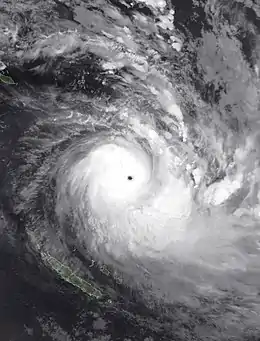
When a system develops into a tropical cyclone below 10°S between 90°E and 160°E, then it will be named by the Australian Bureau of Meteorology (BoM).[6] The names are assigned in alphabetical order and used in rotating order without regard to year.[6]
| List A | |||||||||||
|---|---|---|---|---|---|---|---|---|---|---|---|
| Names | Anika | Billy | Charlotte | Dominic[nb 8] | Ellie | Freddy | Gabrielle | Herman | Ilsa | Jasper | Kirrily |
| Lincoln | Megan | Neville | Olga | Paul | Robyn | Sean | Tasha | Vince | Zelia | ------ | |
| List B | |||||||||||
| Names | Anthony | Bianca | Courtney | Dianne | Errol | Fina | Grant | Hayley | Iggy | Jenna | Koji |
| Luana | Mitchell | Narelle | Oran | Peta | Riordan | Sandra | Tim | Victoria | Zane | ------ | |
| List C | |||||||||||
| Names | Alessia | Bruce | Catherine | Dylan | Edna | Fletcher | Gillian | Hadi | Ivana | Jack | Kate |
| Laszlo | Mingzhu | Nathan | Oriana | Quincey | Raquel | Stan | Tatiana | Uriah | Yvette | ------ | |
| List D | |||||||||||
| Names | Alfred | Blanche | Caleb | Dara | Ernie | Frances | Greg | Hilda | Irving | Joyce | Kelvin |
| Linda | Marco | Nora | Owen | Penny | Riley | Savannah | Trung | Veronica[nb 9] | Wallace | ------ | |
| List E | |||||||||||
| Names | Amber | Blake | Claudia | Damien[nb 10] | Esther | Ferdinand | Gretel | Heath | Imogen | Joshua | Kimi |
| Lucas | Marian | Niran | Odette | Paddy | Ruby | Seth | Tiffany | Vernon | ------ | ----- | |
| References:[6] | |||||||||||
Southern Pacific Ocean (160°E – 120°W)

Within the Southern Pacific basin in the Southern Hemisphere between 160°E – 120°W, a tropical cyclone is named when observations or Dvorak intensity analysis indicate that a system has gale force or stronger winds near the centre which are forecast to continue.[6] The Fiji Meteorological Service (FMS) names systems that are located between the Equator and 25°S, while the New Zealand MetService names systems (in conjunction with the FMS) that develop to the south of 25°S.[6] In order to enable local authorities and their communities in taking action to reduce the impact of a tropical cyclone, the FMS reserves the right to name a system early if it has a high chance of being named.[6] If a tropical cyclone causes loss of life or significant damage and disruption to the way of life of a community, then the name assigned to that cyclone is retired from the list of names for the region.[6] A replacement name is then submitted to the next World Meteorological Organization's RA V Tropical Cyclone Committee meeting.[6] The name of a tropical cyclone is determined by using Lists A — D in order, without regard to the year before restarting with List A.[6] List E contains names that will replace names on A-D when needed.[6]
| List A | |||||||||||||
|---|---|---|---|---|---|---|---|---|---|---|---|---|---|
| Names | Ana | Bina | Cody | Dovi | Eva | Fili | Gina | Hale | Irene | Judy | Kevin | Lola | Mal |
| Nat | Osai | Pita | Rae | Seru | Tam | Urmil | Vaianu | Wati | Xavier | Yani | Zita | ||
| List B | |||||||||||||
| Names | Arthur | Becky | Chip | Denia | Elisa | Fotu | Glen | Hettie | Innis | Julie | Ken | Lin | Maciu |
| Nisha | Orea | Palu | Rene | Sarah | Troy | Uinita | Vanessa | Wano | ------ | Yvonne | Zaka | ||
| List C | |||||||||||||
| Names | Alvin | Bune | Cyril | Daphne | Eden | Florin | Garry | Haley | Isa | June | Kofi | Louise | Mike |
| Niko | Opeti | Perry | Reuben | Solo | Tuni | Ulu | Victor | Wanita | ------ | Yates | Zidane | ||
| List D | |||||||||||||
| Names | Amos | Bart | Crystal | Dean | Ella | Fehi | Garth | Hola | Iris | Jo | Kala | Liua | Mona |
| Neil | Oma | Pana | Rita | Samadiyo | Tasi | Uesi | Vicky | Wasi | ------ | Yasa | Zazu | ||
| List E (Standby) | |||||||||||||
| Names | Aru | Ben | ------ | ------ | Emosi | Feki | Germaine | Hart | Ili | Josese | Kirio | Lute | Mata |
| Neta | ------ | ------ | Rex | ------ | Temo | Uila | Velma | Wane | ------ | ------ | Zanna | ||
| References:[6] | |||||||||||||
South Atlantic Ocean
When a tropical or subtropical storm exists in the South Atlantic Ocean, the Brazilian Navy Hydrographic Center's Marine Meteorological Service names the system using a predetermined list of names. The names are assigned in alphabetical order and used in rotating order without regard to year.[7] The name "Kurumí" replaced "Kamby" in 2018 without being used.
| Names | Arani | Bapo | Cari | Deni | Eçaí | Guará | Iba | Jaguar | Kurumí | Mani | Oquira | Potira | Raoni | Ubá | Yakecan |
|---|---|---|---|---|---|---|---|---|---|---|---|---|---|---|---|
| References:[7] | |||||||||||||||
See also
- Tropical cyclone scales
- Atlantic hurricane season
- South Atlantic tropical cyclone
- Pacific hurricane season
- Pacific typhoon season
- South Pacific tropical cyclone
- North Indian Ocean tropical cyclone
- South-West Indian Ocean tropical cyclone
- Winter storm naming in the United Kingdom and Ireland
- Australian region tropical cyclone
- Regional Specialized Meteorological Center
Notes
- The name Yutu was retired from the 2018 Pacific typhoon season. It will be replaced by either Yingxing, Bailongma, or Ziwei.[12]
- The name Lekima was retired from the 2019 Pacific typhoon season. It will be replaced by either Co-May, Bang-Lang, or Hoa-Sim.[13]
- The name Faxai was retired from the 2019 Pacific typhoon season. It will be replaced in early 2021.[13]
- The name Hagibis was retired from the 2019 Pacific typhoon season. It will be replaced by either Tamaraw, Kusog, or Ragasa.[12]
- The name Kammuri was retired from the 2019 Pacific typhoon season. It will be replaced by either Ryu, Koto, or Tokei.[12]
- The name Phanfone was retired from the 2019 Pacific typhoon season. It will be replaced in early 2021.[13]
- The names Ambali through Jeruto were automatically removed from the naming lists during the 2019–20 South-West Indian Ocean cyclone season. No replacement names have been chosen yet.
- The name Dominic was retired after the 2008-09 Australian region cyclone season, however, a new name has yet to be announced.
- The name Veronica was retired after the 2018-19 Australian region cyclone season, however, a new name has yet to be announced
- The name Damien was retired after the 2019-20 Australian region cyclone season, however, a new name has yet to be announced.[21]
References
- RA IV Hurricane Committee (2020). "9". Regional Association IV (North America, Central America and the Caribbean) Hurricane Operational Plan 2020 (Report No. TCP-30). World Meteorological Organization. Retrieved April 29, 2020.
- WMO/ESCP Typhoon Committee (2019). Typhoon Committee Operational Manual Meteorological Component 2019 (Report). World Meteorological Organization. pp. 1–7, 33–34. Retrieved April 29, 2020.
- "Why and how storms get their names". GMA News. September 27, 2011. Retrieved December 1, 2016.
- Tropical Cyclone Operational Plan for the Bay of Bengal and the Arabian Sea: 2019 (Report) (2019 ed.). World Meteorological Organization. Retrieved April 29, 2020.
- RA I Tropical Cyclone Committee (September 16, 2016). Tropical Cyclone Operational Plan for the South-West Indian Ocean: 2016 (Report No. TCP-12). World Meteorological Organization. pp. 13–14. Archived (PDF) from the original on September 18, 2016. Retrieved September 18, 2016.
- RA V Tropical Cyclone Committee (October 8, 2020). Tropical Cyclone Operational Plan for the South-East Indian Ocean and the Southern Pacific Ocean 2020 (PDF) (Report). World Meteorological Organization. pp. I-4–II-9 (9–21). Retrieved October 10, 2020.
- "NORMAS DA AUTORIDADE MARÍTIMA PARA AS ATIVIDADES DE METEOROLOGIA MARÍTIMA NORMAM-19 1a REVISÃO" (PDF) (in Portuguese). Brazilian Navy. 2018. p. C-1-1. Archived from the original (PDF) on November 6, 2018. Retrieved November 6, 2018.
- Dorst, Neal M (October 23, 2012). "They Called the Wind Mahina: The History of Naming Cyclones" (PPTX). Hurricane Research Division, Atlantic Oceanographic and Meteorological Laboratory. National Oceanic and Atmospheric Administration. Slides 8–72.
- Landsea, Christopher W; Dorst, Neal M (June 1, 2014). "Subject: Tropical Cyclone Names: B1) How are tropical cyclones named?". Tropical Cyclone Frequently Asked Question. United States National Oceanic and Atmospheric Administration's Hurricane Research Division. Archived from the original on March 29, 2015.
- "Tropical Cyclone Names". Australian Bureau of Meteorology. November 10, 2014. Archived from the original on February 22, 2015. Retrieved March 30, 2015.
- "PAGASA replaces names of 2014 destructive typhoons" (Press release). Philippine Atmospheric, Geophysical and Astronomical Services Administration. February 5, 2015. Archived from the original on February 10, 2015. Retrieved March 30, 2015.
- "53rd Typhoon Committee" (PDF). www.typhooncommittee.org. Retrieved February 2, 2021.
- "52nd Typhoon Committee" (PDF). www.typhooncommittee.org. Retrieved February 17, 2020.
- RSMC Tokyo-Typhoon Center (March 24, 2018). "List of names for tropical cyclones adopted by the ESCAP/WMO Typhoon Committee for the western North Pacific and the South China Sea (valid as of 2018): Names of tropical cyclones". Japan Meteorological Agency. Archived from the original on December 12, 2009. Retrieved September 4, 2015.
- "Philippine Tropical Cyclone Names". Philippine Atmospheric, Geophysical and Astronomical Services Administration. Archived from the original on January 30, 2021. Retrieved January 23, 2021.
- "PAGASA replaces Tropical Cyclone "Lando" to "Liwayway"" (Press release). Philippine Atmospheric, Geophysical and Astronomical Services Administration. Archived from the original on November 14, 2015. Retrieved November 4, 2015.
- "IMD Releases New List of Upcoming Cyclone Names Over North Indian Ocean | The Weather Channel - Articles from The Weather Channel | weather.com". The Weather Channel.
- La Reunion Tropical Cyclone Centre (August 31, 2015). "How are the names chosen?". Météo-France. Archived from the original on July 21, 2015. Retrieved September 1, 2015.
- "Tropical Cyclone Naming". World Meteorological Organization. Retrieved June 27, 2016.
- "Cyclone Names". Badan Meteorologi, Klimatologi, dan Geofisika. Archived from the original on March 16, 2015. Retrieved April 11, 2015.
- "Tropical cyclone names". Bureau of Meteorology. Retrieved September 4, 2020.
External links
- AskBOM: How do tropical cyclones get their names?
- United States National Hurricane Center – RSMC Miami
- United States Central Pacific Hurricane Center – RSMC Honolulu
- Japan Meteorological Agency – RSMC Tokyo
- India Meteorological Department – RSMC New Delhi
- Météo-France – RSMC La Reunion
- Indonesia Badan Meteorologi & Geofisika – TCWC Jakarta
- Australia Bureau of Meteorology – TCWC Perth, Darwin, Brisbane
- Fiji Meteorological Service – RSMC Nadi
- Meteorological Service of New Zealand – TCWC Wellington
- Brazilian Navy Hydrography Center – Marine Meteorological Service
- Philippine Atmospheric, Geophysical and Astronomical Services Administration
- 53rd session of ESCAP/WMO Typhoon Committee